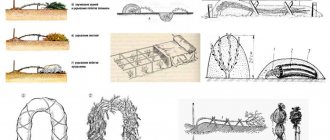Repeat well and repeat again: we don’t have roses that don’t need shelter for the winter.
Helga Consultant FORUMHOUSE
These are flowers not of our climate; only various “rose hips” can afford to spend the winter uncovered.
Absolutely all roses need to be covered. In this article we will look at several important aspects of this process:
- Is it necessary to hill up the roots of roses?
- Is it necessary to tear off the leaves and process the cuts before wintering roses?
- How to scare mice away from roses during the winter.
- When to bend stems.
- Successful examples of winter shelters.
Do I need to cover roses for the winter?
Roses are a fairly cold-resistant crop, but the bushes react negatively to severe frosts. When the temperature drops significantly, the shoots freeze and the roots suffer; with the onset of spring, the plant develops more slowly. If the winter is expected to be cold, you can and should cover your roses - even simple insulation will help them survive the frost.
With proper protection, ornamental bushes:
- do not suffer from cold and dry winds;
- retain enough moisture at the roots during the winter;
- do not die due to sudden temperature changes;
- They begin to develop faster with the onset of spring.
It is necessary to cover the crop especially carefully if the bushes grow in an open place where there are strong drafts in winter.
Wind in winter poses an even greater danger to rose bushes than frost.
Don't rush to cover!
Hiding too early is, as a rule, a manifestation of the gardener’s excessive care for his pets. For some reason, it is believed that roses are sissies that are afraid of even a slight cold snap. But this is not at all true! They tolerate frosts well down to -20-25 degrees, and can withstand significantly lower temperatures for a short time.
With a gradual decrease in air temperature, natural hardening of plants occurs, in whose tissues complex biochemical processes occur at this time. Premature covering interrupts them, depriving the shoots of natural light and disrupting the required temperature regime. In addition, autumn weather is often unstable; after frosts, thaws come, and conscientiously wrapped bushes simply damp out.
However, you should also not be late with winter protection of roses - if the temperature drops sharply, the shoots may suffer. Experienced gardeners carry out sheltering in stages, without covering the bushes completely until a stable negative air temperature has established and the soil has frozen.
What roses need to be covered for the winter
Some crop varieties suffer from winter cold more than others. With the onset of autumn, it is imperative to cover:
- hybrid tea;
- bush;
- ground cover;
- floribunda;
- standard;
- climbing roses.
The listed types require insulation both in the northern regions and in the middle zone.
Attention! Park, Canadian and hybrid roses, as well as rugosa, alba and spinozissima roses, do not need to be covered for the winter. Cultivated rose hips usually do not need insulation.
Different varieties - different shelters
- Standard roses
The main task is not to damage the standard. To do this, a tunnel is made on the side in which it was directed during landing. In the direction of the tunnel, the bush is carefully tilted towards the ground. After this, the graft is generously sprinkled with dry soil, and the roots are insulated with fertile soil mixture. And only after this the plant can be covered according to the chosen method.
- Ground cover roses
They are easier to cover for the winter than all the others. It is enough to protect the shortest ones with spruce branches, lay lutrasil on top and secure its edges with bricks or garden pins. Those that grow up to 1 m in height can be cocooned.
- climbing roses
The soil around the bushes is covered with wooden boards or polystyrene foam. Starting from the first week of September, it is necessary to gradually (so as not to break) bend the climbing rose to the ground. Every week the branches sink lower and become fixed. In the end, they should end up lying on the bedding that you prepared in advance. It is strictly not recommended to leave it on a support in winter.
- Park roses
These are one of the most winter-hardy varieties. However, they also require preparation for winter. It is necessary to apply peat powder to the root system. Then either bend the shoots to the ground and build a frame, or leave it like that and protect it with a cocoon.
- Cordana roses
They require careful preparation for winter, as they are essentially indoor plants. If the plant is grown in a tub, you just need to bring it into the house (greenhouse, barn). If it grows in the ground, it is covered with spruce branches and one of the good synthetic materials.
Those who initially choose varieties of roses that do not require shelter have the least hassle. These include:
William Baffin, Blanc double de Coubert, Charles Albanel, Snow Pavement, Hansa, Jens Munch, Queen of the North, Polar Star, Emily, Romance, Fairy, Lilac Rain, Heidetraum, Sunny Rose and others.
Timing for covering roses for the winter
Videos on how to cover roses for the winter emphasize that the procedure must be carried out at the right time. If you wrap the bushes too early, then in warm weather they will lock up and begin to hurt. If covered late, the crop may freeze and go into winter weakened.
When choosing the timing of insulation, you need to focus on the climatic features of the region. To cover rose bushes you need to:
- at the end of October or the first half of November in the middle zone;
- until mid-October in the Urals and Siberia;
- in the first half of November in the southern regions.
The procedure is carried out on a dry day without rain or snow. It is best to cover the crop after a stable daytime temperature has established itself at -5 ° C, and there is no longer any warming in the weather forecast.
Advice! When choosing the timing, you can focus on the condition of the soil. If it is frozen 1 cm deep and does not thaw during the day, it is time to insulate the rose bushes in the garden.
To spud or not?
There is still debate among rose growers about whether hilling is beneficial for rose bushes or, on the contrary, harmful. You have the right to resolve this issue as you see fit, since much depends on local weather and climatic conditions, as well as the varieties grown. However, it is recommended to always take into account a number of significant nuances.
- Firstly, do not earth up roses with moisture-intensive materials (peat, sawdust, etc.) if the winter in your region is unstable: stems located in a cold, damp substrate easily rot.
- Secondly, do not hill up roses if in the spring you come to the dacha only after it gets warmer and the snow has completely melted: you need to unhill the roses as early as possible so that they do not dry out.
- Finally, don't use loose materials that attract mice (like hay or wood shavings).
In all cases, it is useful to add sand to the base of the stems, under the selected materials for hilling: it does not retain moisture well and can prevent the appearance of mold and rot.
Preparing roses for shelter for the winter
Before protecting roses from frost, it is necessary to carry out preparatory procedures:
- Feed the bushes. In autumn, roses need phosphorus and potassium - these substances strengthen the crop's endurance before cold weather.
- Perform sanitary pruning. All leaves from the rose must be torn off, and diseased, dried out and broken shoots are also removed.
- Clear the area of plant debris. All dry leaves and cut stems are removed from the flowerbed, weeds are pulled out and the soil is dug up. Pests and pathogens often overwinter in the ground at the roots of roses. Autumn cleaning of the site helps eliminate insects and fungal spores.
Shortly before covering the roses, it is also useful to perform preventive treatment of the crop with copper-containing preparations. It is recommended to use HOM, Bordeaux mixture, copper sulfate, as well as Topaz and Skor preparations for spraying. Treatment will not only protect the crop from diseases and pests, but will also generally increase its winter hardiness.
What's the right way?
Now let's talk about what you definitely need to do for your roses in order to prepare them for the winter trials in the best possible way. Here is a rough work plan for the fall:
| Month | Main tasks |
| September | 1. Fertilize with phosphorus-potassium fertilizers. 2. Ensure optimal watering, avoiding overdrying and waterlogging. 3. Pinch out rapidly developing shoots. 4. Prepare the necessary materials for shelter. 5. Plant and replant roses. |
| October | 1. Complete planting (transplanting) roses. 2. Gradually (in several stages) trim the leaves, starting from the bottom of the bush. 3. Remove all plant debris from the rose garden and loosen the soil. 4. Remove climbing roses from their supports and prepare them for shelter. 5. Gradually (before the onset of cold weather) begin to bend down tall bushes. 6. Carry out preventive treatment to protect against diseases 6. Hill up roses (if necessary). 7. Prepare materials and install shelter structures. 8. In the event of persistent cold weather, trim and cover the bushes. |
| November | 1. Trim the bushes (depending on the characteristics of the garden group). 2. Install shelters (or check previously installed ones). 3. Take care to protect plants from rodents. 4. Carry out snow retention. |
Of course, the specific deadlines for completing certain works depend on the weather and climatic conditions of your area. Please note that the best protection against frost for roses will be snow cover, so pay attention to snow retention: if necessary, install shields, use spruce branches and other available means to preserve the snow around the rose bushes.
What is the best way to cover roses for the winter?
Some varieties of roses require the shoots to be bent to the ground before the onset of winter, while other types must be wrapped along the crown without tilting. There are several popular ways to insulate crops, suggesting the use of different materials.
Film
Film is one of the most affordable, but controversial in terms of efficiency, insulation materials. You can cover roses with polyethylene, but with each thaw it will need to be opened slightly to give the plants access to oxygen. Otherwise, the crop will smear under the film, begin to get sick and will not survive until spring.
Advice! Covering the bushes with polyethylene is allowed if it is possible to constantly monitor the plantings during the winter.
So that the roses under the film can breathe, you need to make holes in the material for air or leave a small gap
Sackcloth
You can cover your roses with the onset of winter with natural burlap. It protects the bushes well from the cold and at the same time allows air to pass through, so the plants under such material do not rot or rot.
As a rule, burlap is pulled over a frame installed around the plantings, or standard varieties are wrapped directly over the crown. It is important to choose the most natural fabric with a small synthetic content and without a polyethylene lining. The disadvantages of burlap include its ability to absorb moisture. During a thaw, the material may become wet, and during subsequent frosts it will freeze.
You can cover roses only with clean material, since fungal spores may be present in old vegetable burlap
Nonwovens
You can cover roses before the onset of winter with agrofibre, lutrasil, spunbond or geotextile. Such materials allow air to pass through perfectly, but protect the crop from frost.
Since agrofibre and spunbond get wet from rain and snow, it is recommended to lay them in two layers. You can also stretch the non-woven material on a rigid frame - in this case it will not be in direct contact with the shoots of the plant.
For winter shelter, it is recommended to take white non-woven material - it will not heat up much under the sun's rays
Cardboard
Cardboard is a versatile material and can serve as both a shelter for roses and a rigid frame. It protects ornamental bushes well from wind and cold air, but allows oxygen to pass through and allows plants to breathe.
The disadvantage of the material is that it gets wet from moisture and can fall apart in warm winters. To ensure that the cardboard lasts until spring, it is recommended to additionally cover it with spunbond or film.
In cold regions, cardboard can be used in the construction of multi-layer covering structures
Lapnik
You can build a shelter for rose bushes in Siberia or in the middle zone from spruce branches. The material is especially well suited for single adult plants located at a decent distance from each other.
The spruce branches are simply thrown over the roses from all sides, building a kind of hut. Spruce or pine branches retain heat rising from the ground, allow air to pass through, but block cold wind. Excess moisture evaporates from the soil without hindrance. Even in a warm winter, the ornamental crop feels good and does not rot.
Attention! Lapnik has antiseptic properties and additionally protects plants from bacteria and fungi.
The cover made of spruce branches does not need to be removed at every thaw - roses usually do not rot under coniferous branches
Plastic bottles
If the plants are young and fairly short, you can cover the roses with plastic bottles for the winter. For empty containers with a volume of 2 to 5 liters, the lower part is cut off, and closer to the neck, several small holes are made with a soldering iron or nail. The rose is spudded, and then covered with a bottle and lightly screwed into the ground.
At first, it is recommended to keep the neck of the container open. The cork is wrapped only after snow has fallen. In the southern regions and in the middle zone, plants can be covered exclusively with cut bottles. In cold areas, it is worth throwing spruce branches or stretching spunbond over the constructed greenhouses. With the onset of spring weather, the bottles are first opened and then completely removed so that the roses do not dry out from lack of air.
You can cover roses with plastic bottles not only from frost and wind, but also from rodents
Is it possible to cover roses with straw for the winter?
In addition to spruce branches, you can cover roses for the winter with straw. It blocks cold air well and prevents the rapid melting of snow, which also serves as insulation for the bushes.
The disadvantage of straw is its high ability to get wet. In warm winters, the material quickly cakes, becomes compacted and begins to rot and mold. Therefore, it is recommended to use straw only in the north. Moreover, with the onset of a thaw, the shelter is quickly removed.
Warning! Small garden rodents that can damage plant roots often overwinter in dry hay.
Rose straw is recommended to be used in combination with non-woven materials
Is it possible to cover roses for the winter with polycarbonate?
Polycarbonate sheets insulate ornamental crops well from cold and moisture, but create a greenhouse effect. Covering bushes with such material is allowed only if access to oxygen is ensured. For example, you can build a kind of hut and leave the plants under it until it really gets cold, without covering the structure from the sides.
Closer to frost, polycarbonate must be additionally covered with agrofibre or other material on top
How to make mouse prophylaxis
For some rodent reason, mice love roses as much as apple trees and grapes, and thorns don't stop them. During the years of mouse pandemics, the rose garden can suffer very seriously.
GALAS
This year my weavers have been chewed up a lot.
The famous Russian scientist and breeder Ivan Puchkin gave the participants of our portal an excellent means of prevention: this is ordinary birch tar. Ivan Aleksandrovich soaks pieces of old felt boots with tar and places them next to the plants.
Members of our portal also successfully use tar to repel mice; the experience is always positive.
MiLeDi Member of FORUMHOUSE
Mice really don't like it! Of course, this is more time-consuming than scattering poison bait. I have been using the tar for 5 years now, it is not washed off by rain, the smell under the cover of roses remains until spring. There are fewer under bushes and trees, but mice also don’t like them.
Here is another way to use birch tar (the product is sold at the pharmacy).
- We hang it on branches and wrap ribbons soaked in tar around the posts.
- We place pieces of cotton wool soaked in tar in dangerous places where mouse migrations occur.
Ways to cover roses for the winter
There are several ways to protect roses from the cold before the onset of winter. Which one to choose depends on the type and height of the bush.
Hilling
It is recommended to hill up low-growing varieties of roses with flexible climbing shoots for the winter. The procedure is carried out according to the following scheme:
- With the onset of autumn, the area with roses is cleared of debris and the branches of the plants are bent to the ground.
- A mixture of garden soil, peat and sand is poured into the center of the bush - it must be dry.
- The shelter is made about 25 cm high; the lower buds of the plant should be completely hidden under the substrate.
- With the onset of real cold weather, an additional frame is built over the roses or spruce branches are simply thrown over the soil mixture. After snow falls, you can also cover the crop with a dense snowdrift.
Hilling is recommended to be carried out on a dry and clear day at low sub-zero temperatures. The procedure is not performed in rain and warm autumn weather.
Attention! Hilling in combination with other methods is especially recommended for northern regions.
Hilling up well protects rose roots and growth buds from cold weather
Frame method
You can cover medium-sized varieties of roses for the winter by constructing a frame. They do it according to this scheme:
- The roots of the rose are sprinkled with soil in a layer of 20-40 cm. The shoots are bent to the ground or cut off, and then covered with straw or spruce branches.
- Metal rods or wooden sticks are dug into the ground 5-10 cm and connected together into a single structure. The height of the frame should be such that the rose stems do not extend beyond its limits.
- A covering material is pulled over the installed structure - burlap, lutrasil, film or spunbond. The edges are pressed to the ground with bricks or nailed with stakes.
The frame is convenient because there is enough air under it for the roses, and they do not damp out in winter. The shelter can be made in the form of a rectangle, cone or hut.
The base for the frame can be built in the fall, and with the arrival of cold weather the crop can be completely covered
Shelter without frame
Frameless shelter is used for old rose bushes or creeping varieties. The insulating structure is constructed as follows:
- The rose is bent to the surface of the ground or cut to a small height.
- The root area is covered with a mixture of soil, sand and peat.
- The selected insulating material is spread over the shoots.
- Bricks are laid along the edges or stakes are driven in to prevent the shelter from being blown away by the wind.
If you need to insulate a tall standard rose for the winter, then the plant is also pre-hilled, and then the crown is wrapped in any non-woven material and tied around the trunk at the bottom. The shelter should not be secured too tightly - fresh air must flow under it.
With the onset of spring, the frameless cover from the roses is gradually removed and removed completely closer to May.
When to bend roses
Despite the fact that roses can easily tolerate light frosts, and it is recommended to cover them even in light frosts, it is better not to postpone bending down until then.
Pucha Member of FORUMHOUSE
At a stable -5, the stems will be fragile and may break during installation.
Climbing and standard roses, as well as floribundas, are bent in mid-autumn before the stems lose their flexibility.
Climbing roses are bent down long and gradually: the plant is tied with a string, the second end of the string is tied to a peg (shish kebab skewer) stuck in the ground. Once a week, the rose is slowly pulled to the ground by a rope until the distance above the ground is 50 cm. The plant is covered with a double layer of 60-grade lutrastil on top.











